 The price of road fuel is falling. Petrol and diesel prices in the UK are now at their lowest level since February 2011. The average pump price for a litre of unleaded petrol has fallen to 130.44p in November – down nearly 8p per litre since September.
The price of road fuel is falling. Petrol and diesel prices in the UK are now at their lowest level since February 2011. The average pump price for a litre of unleaded petrol has fallen to 130.44p in November – down nearly 8p per litre since September.
According to the AA, the reduction in price equates to a fall in the average monthly expenditure on petrol of a two-car family of £14.49 – down from £252.54 to £238.05. This saving can be used for spending on other things and can thus help to boost real aggregate demand. The fall in price has also helped to reduce inflation.
But will lower fuel prices lead to a rise in fuel consumption? In other words, will some of the savings people make when filling up be used for extra journeys? If so, how much extra will people consume? This, of course depends on the price elasticity of demand.
The following articles explain why the price of road fuel has fallen and look at its consequences.
Webcast
 Good news for motorists as fuel prices fall in the East ITN (22/11/13)
Good news for motorists as fuel prices fall in the East ITN (22/11/13)
Articles
November fuel price update Automobile Association (22/11/13)
Finally there is good news for motorists as petrol prices hit lowest level since 2011 The Telegraph, Steve Hawkes (22/11/13)
Petrol prices fall to lowest level for almost three years as strong pound gives motorists relief on the forecourt This is Money, Lee Boyce (22/11/13)
Falling petrol prices boost motorists The Guardian (22/11/13)
Data
Weekly road fuel prices Department of Energy & Climate Change
Europe Brent Spot Price US Energy Information Administration
Spot exchange rate, US $ into Sterling Bank of England
Questions
- Why have the prices of petrol and diesel fallen?
- Illustrate the fall in price of road fuel on a demand and supply diagram.
- How does the size of the fall in price depend on the price elasticity of demand for road fuel?
- If a fall in price results in a fall in expenditure on road fuel, what does this tell us about the price elasticity of demand?
- Why may the price elasticity of demand for road fuel be more elastic in the long run than in the short run?
- If a motorist decides to spend a fixed amount of money each week on petrol, irrespective of the price, what is that person’s price elasticity of demand?
- Using the links to data above, find out what happened to the dollar price of sterling and the Brent crude oil price between September and November 2013.
- How do changes in the exchange rate of the dollar to the pound influence the price of road fuel?
- If the price of oil fell by x per cent, would you expect the price of road fuel to fall by more or less than x per cent? Explain.
- Why do petrol prices vary significantly from one location to another?
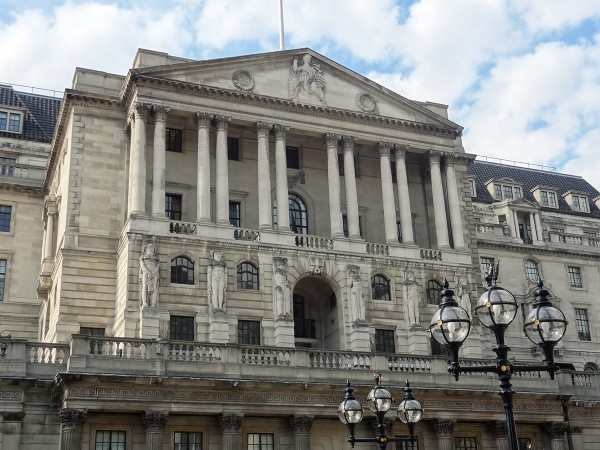 The Consumer Prices index (CPI) measures the rate of inflation and in October, this rate fell to 2.2%, bringing inflation to its lowest level since September 2012. For many, this drop in inflation came as a surprise, but it brings the rate much closer to the Bank of England’s target and thus reduces the pressure on changing interest rates.
The Consumer Prices index (CPI) measures the rate of inflation and in October, this rate fell to 2.2%, bringing inflation to its lowest level since September 2012. For many, this drop in inflation came as a surprise, but it brings the rate much closer to the Bank of England’s target and thus reduces the pressure on changing interest rates.
The CPI is calculated by calculating the weighted average price of a basket of goods and comparing how this price level changes from one month to the next. Between September and October prices across a range of markets fell, thus bringing inflation to its lowest level in many months. Transport prices fell by their largest amount since mid-2009, in part driven by fuel price cuts at the big supermarkets and this was also accompanied by falls in education costs and food. The Mail Online article linked below gives a breakdown of the sectors where the largest price falls have taken place. One thing that has not yet been included in the data is the impact of the price rises by the energy companies. The impact of his will obviously be to raise energy costs and hence we can expect to see an impact on the CPI in the coming months, once the price rises take effect.
 With inflation coming back on target, pressures on the Bank of England to raise interest rates have been reduced. When inflation was above the target rate, there were concerns that the Bank of England would need to raise interest rates to cut aggregate demand and thus bring inflation down.
With inflation coming back on target, pressures on the Bank of England to raise interest rates have been reduced. When inflation was above the target rate, there were concerns that the Bank of England would need to raise interest rates to cut aggregate demand and thus bring inflation down.
However, the adverse effect of this would be a potential decline in growth. With inflation falling to 2.2%, this pressure has been removed and hence interest rates can continue to remain at the record low, with the objective of stimulating the economy. Chris Williamson from Markit said:
The easing in the rate of inflation and underlying price pressures will provide greater scope for monetary policy to be kept looser for longer and thereby helping ensure a sustainable upturn in the economy … Lower inflation reduces the risk of the Bank of England having to hike rates earlier than it may otherwise prefer to, allowing policy to focus on stimulating growth rather than warding off rising inflationary pressures.
The lower rate of inflation also has good news for consumers and businesses. Wages remain flat and thus the reduction in the CPI is crucial for consumers, as it improves their purchasing power. As for businesses, a low inflation environment creates more certainty, as inflation tends to be more stable. Businesses are more able to invest with confidence, again benefiting the economy. Any further falls in the CPI would bring inflation back to its target level of 2% and then undoubtedly concerns will turn back to the spectre of deflation, though with the recent announcements in energy price rises, perhaps we’re getting a little ahead of ourselves! Though we only need to look to countries such as Spain and Sweden where prices are falling to realise that it is certainly a possibility. The following articles consider the data and the impact.
UK inflation falls in October: what the economists say The Guardian, Katie Allen (12/11/13)
British inflation hits 13-month low, easing pressure on central bank Reuters, David Milliken and William Schomberg (12/11/13)
UK inflation falls to 2.2% in October BBC News (1211/13)
UK inflation falls to 13-month low: reaction The Telegraph (12/11/13)
Fall in inflation to 2.2% welcome by government The Guardian, Katie Allen (12/11/13)
Inflation falls to lowest level for a year as supermarket petrol price war helps ease the squeeze on family finances Mail Online, Matt Chorley (12/11/13)
Inflation falls to its lowest level for more than a year as consumers benefit from petrol pump price war Independent, John-Paul Ford Rojas (12/11/13)
UK inflation slows to 2.2%, lowest level in a year Bloomberg, Scott Hamilton and Jennifer Ryan (12/11/13)
Are we facing deflation? Let’s not get carried away The Telegraph, Jeremy Warner (12/11/13)
Questions
- How is the CPI calculated?
- Use an AD/AS diagram to illustrate how prices have been brought back down. Is the reduction in inflation due to demand-side or supply-side factors?
- What are the benefits of low inflation?
- The Telegraph article mentions the possibility of deflation. What is deflation and why does it cause such concern?
- Explain why a fall in the rate of inflation eases pressure on the Bank of England.
- How does the rate of inflation affect the cost of living?
- Is a target rate of inflation a good idea?
 UK house prices are incredibly volatile. This helps to explain the fascination that many of us have with the British housing market. According to the latest ONS house Price Index, the average UK house price in August 2013 was 3.8 per cent higher than 12 months earlier. The rates varied across the home nations: 4.1 per cent in England, 1.1 per cent in Northern Ireland, 1 per cent in Wales and -0.7 per cent in Scotland. Here we take a look at international house price inflation rates. Is the British housing market as unique as we think it is?
UK house prices are incredibly volatile. This helps to explain the fascination that many of us have with the British housing market. According to the latest ONS house Price Index, the average UK house price in August 2013 was 3.8 per cent higher than 12 months earlier. The rates varied across the home nations: 4.1 per cent in England, 1.1 per cent in Northern Ireland, 1 per cent in Wales and -0.7 per cent in Scotland. Here we take a look at international house price inflation rates. Is the British housing market as unique as we think it is?
Let’s begin at home (excuse the pun). If we take the period from 1970 Q1 to 2013 Q2, the average annual rate of house price inflation across the UK is 9.7 per cent. The average rate in England is 9.8 per cent, as it is in Wales too, while in Scotland it is 9.0 per cent and in Northern Ireland it is 8.8 per cent. While the long-term averages of the UK nations are rather more similar than perhaps we might expect, what is quite interesting is the differences that emerge in more recent times. If we take the period from July 2008 to August 2013, the average annual rate of house price inflation in the UK is -0.2 per cent, in England it is 0.1 per cent, in both Wales and Scotland it is -1.0 per cent, while in Northern Ireland it is -11 per cent.
The recent English average is heavily distorted by London and to a lesser extent the rest of the South East. In London and the South East the average annual house price inflation rates since July 2008 have been 2.6 per cent and 0.2 per cent respectively. In all the other English regions the average rate has been negative. In my own region of the East Midlands the average rate has been -1.2 per cent – this is exactly the UK average if both London and the South East are removed from the figures.
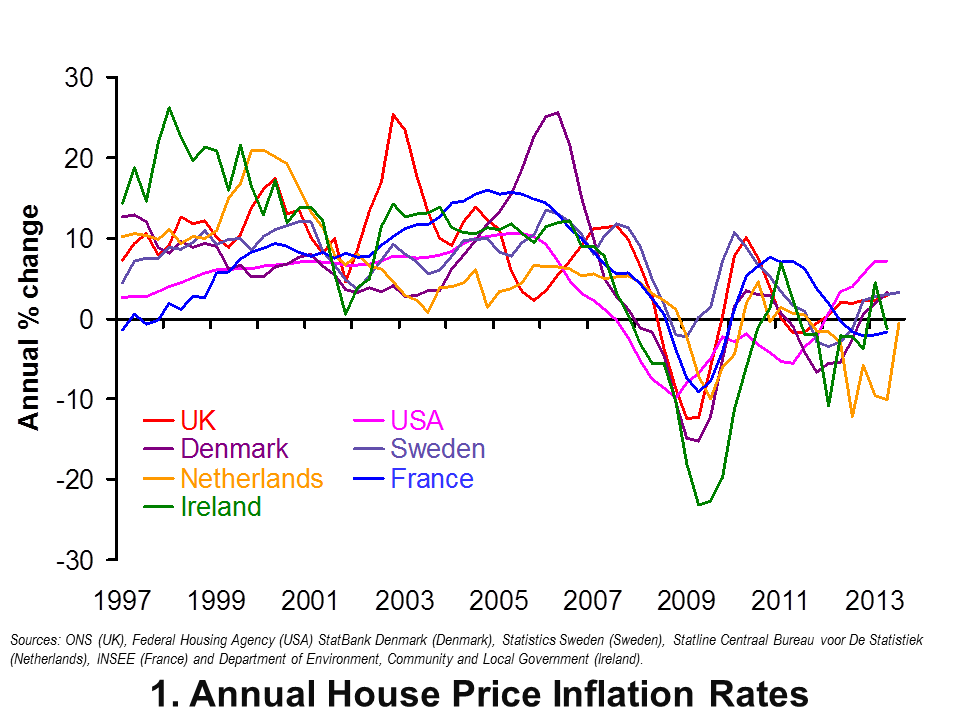 Now let’s go international. Chart 1 shows annual house price inflation rates for the UK and six other countries since 1997. Interestingly, it shows that house price volatility is a common feature of housing markets. It is not a uniquely British thing. It also shows that the USA is notable for its relatively robust house price inflation rates of late. In the first half of 2013 annual house price inflation has been running at 7 per cent in America, compared with 2 to 3 per cent here in the UK. In contrast, the Netherlands has seen near-double digit rates of house price deflation over the past year, albeit with a rebound in the third quarter of this year. (Click here to download a PowerPoint of the chart.)
Now let’s go international. Chart 1 shows annual house price inflation rates for the UK and six other countries since 1997. Interestingly, it shows that house price volatility is a common feature of housing markets. It is not a uniquely British thing. It also shows that the USA is notable for its relatively robust house price inflation rates of late. In the first half of 2013 annual house price inflation has been running at 7 per cent in America, compared with 2 to 3 per cent here in the UK. In contrast, the Netherlands has seen near-double digit rates of house price deflation over the past year, albeit with a rebound in the third quarter of this year. (Click here to download a PowerPoint of the chart.)
The chart captures very nicely the effect of the financial crisis and subsequent economic downturn on global house prices. Ireland saw annual rates of house price deflation touch 23 per cent in 2009 compared with rates of deflation of 12 per cent in the UK. Denmark too suffered significant house price deflation with prices falling at an annual rate of 15 per cent in 2009.
House price volatility appears to be an inherent characteristic of housing markets worldwide. Let’s now consider the extent to which house prices rise over the longer term. In doing so, we consider real house price growth after having stripped out the effect of consumer price inflation. Real house price growth measures the growth of house prices relative to consumer prices.
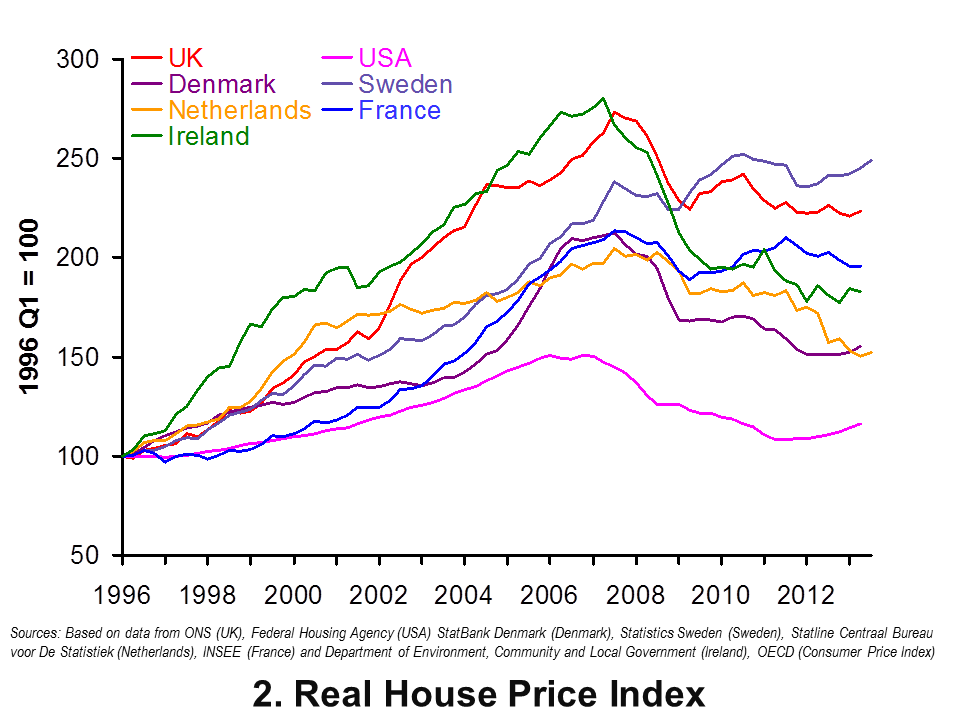 Chart 2 shows real house prices since 1996 Q1. (Click here to download a PowerPoint of the chart.) It shows that up to 2013 Q2, real house prices in the UK have risen by a factor of 2.24, i.e. they are two and a quarter times higher. This is a little less than in Sweden where prices are 2.5 times higher.
Chart 2 shows real house prices since 1996 Q1. (Click here to download a PowerPoint of the chart.) It shows that up to 2013 Q2, real house prices in the UK have risen by a factor of 2.24, i.e. they are two and a quarter times higher. This is a little less than in Sweden where prices are 2.5 times higher.
Chart 2 shows that the increase in real house prices in the UK and Sweden is significantly higher than in the other countries in the sample. In particular, in the USA real house prices in 2013 Q2 are only 1.16 times higher than in 1996 Q1. In the US actual house prices, when viewed over the past 17 years or so, have grown only a little more quickly than consumer prices.
The latest data on house prices suggest that house price volatility is not unique to the UK. However the rate of growth over the longer term relative to consumer prices is markedly quicker than in many other countries. It is this which helps to explain the amount of attention paid to the UK housing market – and not least by policy-makers.
Data
House Price Indices: Data Tables Office for National Statistics
Articles
First time buyers in race to beat house price rises Telegraph, Nicole Blackmore (8/11/13)
House prices soar by £13,000: Values rise at fastest rate for 3 years Express, Sarah O’Grady (7/11/13)
House prices: ‘south-east set to outpace London’ for first time in a decade Guardian, Jennifer Rankin (6/11/13)
UK house prices hit record level, says ONS BBC News, (15/10/13)
UK house prices rise at fastest pace in three years in October – Nationwide Reuter (31/11/13)
 Jonathan Portes: UK house prices a ‘force of evil’ BBC News, (5/11/13)
Jonathan Portes: UK house prices a ‘force of evil’ BBC News, (5/11/13)
Questions
- What is meant by the annual rate of house price inflation? What about the annual rate of house price deflation?
- What factors are likely to affect housing demand?
- What factors are likely to affect housing supply?
- Explain the difference between nominal and real house prices. What does a real increase in house prices mean?
- How might we explain the recent differences between house price inflation rates in London and the South East relative to the rest of the UK?
- What might explain the very different long-term growth rates in real house prices in the USA and the UK?
- Why were house prices so affected by the financial crisis?
- What factors help explain the volatility in house prices?
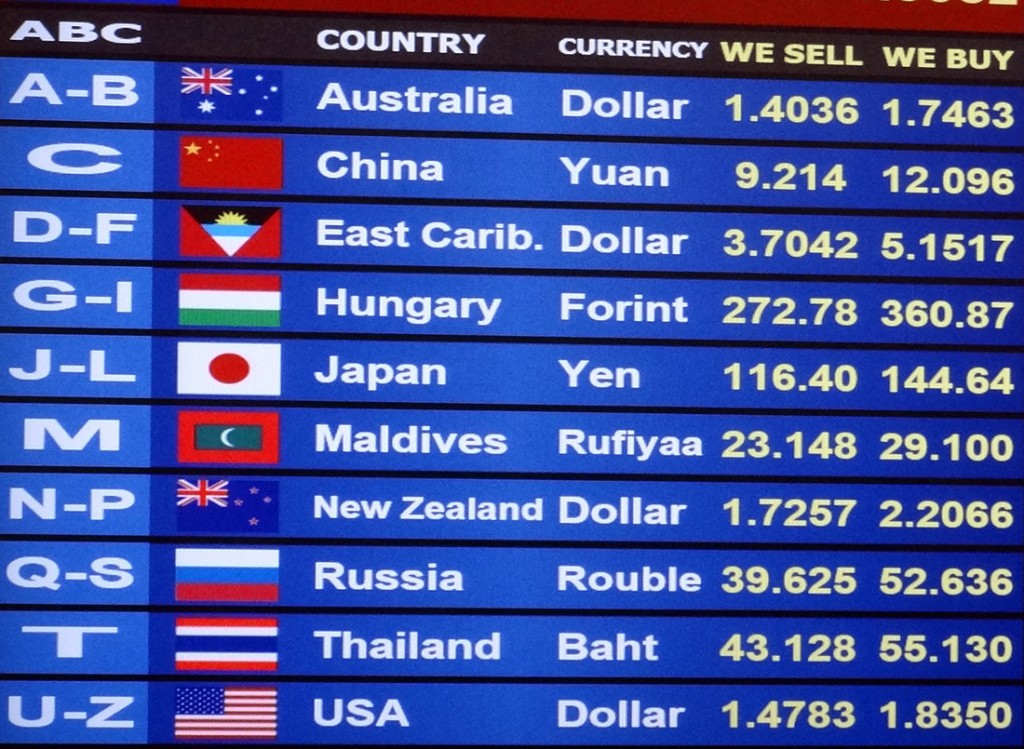 Compared with pre-financial crisis levels, the British pound is significantly weaker when measured against a basket of foreign currencies. In this blog we provide a further update of Appreciating a depreciating pound which was published back in early December 2012. The significance of the depreciation should be seen in the context of the UK as an open, island-economy where the ratio of exports to GDP in 2012 was close to 32%.
Compared with pre-financial crisis levels, the British pound is significantly weaker when measured against a basket of foreign currencies. In this blog we provide a further update of Appreciating a depreciating pound which was published back in early December 2012. The significance of the depreciation should be seen in the context of the UK as an open, island-economy where the ratio of exports to GDP in 2012 was close to 32%.
The competitiveness of our exports is, in part, affected by the exchange rate. Floating exchange rates are notoriously volatile. For example, some of the articles below show how sensitive the British pound can be latest news on the economy. However, since the autumn of 2007 we have observed a significant depreciation of the UK exchange rate. A depreciation helps to make our exports more competitive abroad and can potentially boost aggregate demand.
Rather than simply focus on bilateral exchange rates and so at the British pound separately against other foreign currencies, we can estimate an average exchange rate against a whole bundle of currencies. The average rate is calculated by weighting the individual exchange rates by the amount of trade between Britain and the other countries. This trade-weighted exchange rate is known as the effective exchange rate.
In analysing the competitiveness of the exchange rate, we can go one step further and adjust for the average (domestic currency) price of our exports relative to the average (foreign currency) price of those goods we import. Therefore, as well as the nominal (actual) effective exchange rate we can calculate a real effective exchange rate. If the average price of our exports rises relative to the average price of imports, the real effective exchange rate rises relative to the nominal rate. It means that we are able to obtain a larger volume of imports from selling a given volume of exports.
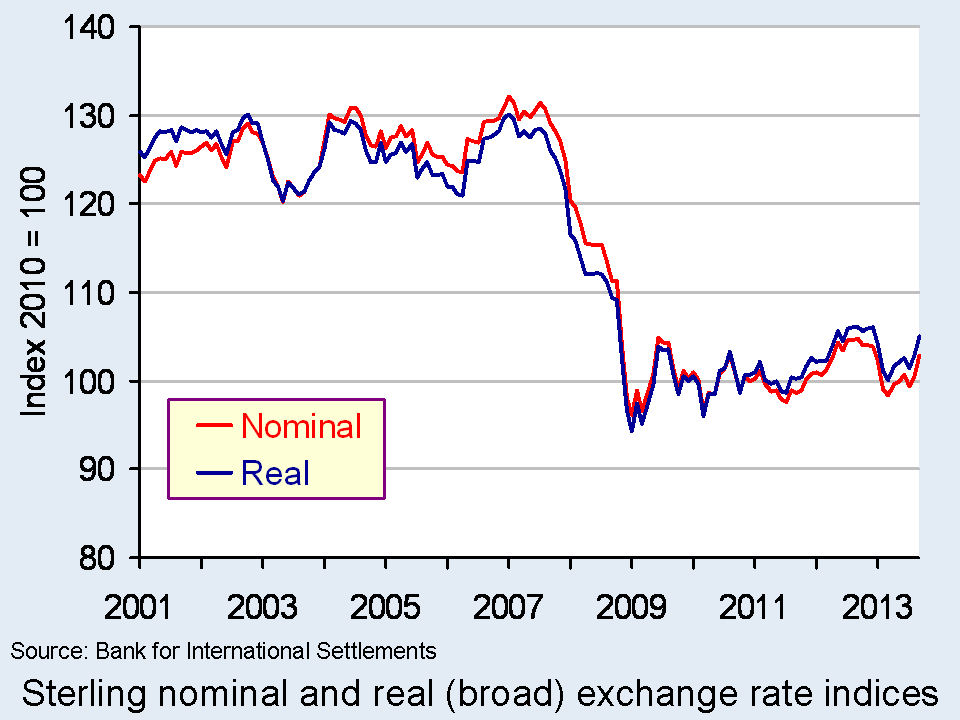 The chart shows the nominal (actual) and real effective exchange rate for the British pound since 2001. The chart shows clearly how from the autumn of 2007 the effective exchange rate fell sharply both in nominal and real terms.
The chart shows the nominal (actual) and real effective exchange rate for the British pound since 2001. The chart shows clearly how from the autumn of 2007 the effective exchange rate fell sharply both in nominal and real terms.
Over the period from July 2007 to January 2009 the nominal effective exchange rate fell by 26.8 per cent while the real effective exchange rate fell by 26.6 per cent. In other words, the British pound depreciated more than one-quarter over an 18-month period. In comparison, the American dollar rose by 5.3 per cent in nominal terms and by 1.9 per cent in real terms. (Click here to download a PowerPoint of the chart.)
If we move the clock forward, we observe an appreciation of the British pound between July 2011 and September 2012. Over this period, the British pound appreciated by 7.0 per cent in nominal terms and by 7.3 per cent in real terms. However, this appreciation had effectively been wiped-out when by March 2013 the nominal rate had depreciated by 6.1 per cent and by 5.6 per cent in real terms. Subsequently, there has been a slight appreciation once more. As of September, the nominal rate had risen by 4.5 per cent and the real rate by 4.8 per cent.
While, as recent figures help to demonstrate, the British pound continues on its roller-coaster ride, there has been a very marked depreciation since the giddy-days prior to the financial crisis. The facts show that when comparing the effective exchange rate in September 2013 with July 2007 the British pound was 21.8 per cent lower in nominal terms and 18.3 per cent in real terms. Over the same period, the US dollar, for example, was only 1.3 per cent lower in nominal terms and 6.1 per cent in real terms. This constitutes a major competitive boost for our exporters. Nonetheless, there remain uncertainty about just how much British exporters can take advantage of this, the amount that it will boost British growth and the impact it will make on the country’s chronic balance of trade deficit in goods which was close to 7 per cent of GDP in 2012.
Data
Statistical Interactive Database – interest and exchange rate rates data Bank of England
BIS effective exchange rate indices Bank for International Settlements
Market Data: Currencies BBC News
Recent Articles
Unexpected drop in factory output dents sterling Reuters UK, Jessica Mortimer (9/10/13)
Pound Forecasts Soar as BOE’s Carney Signals Shift: Currencies Bloombeg, Lukanyo Mnyanda and Emma Charlton (19/10/13)
Pound Advances as U.K. Financial Optimism Improves; Gilts Rise Bloombeg, Emma Charlton (7/10/13)
Re-balancing and the re-industrialisation of Britain BBC News, Linda Yueh (13/10/13)
Signs of recovery abound but with little consensus on future course Financial Times, Chris Giles and Sarah O’Connor (31/10/13)
Previous Articles
Pound depreciates Vs dollar to lowest level since Aug 16 Bloomberg, Emma Charlton (5/2/13)
Pound advances against euro on Italy speculation; Gilts decline Bloomberg, Lucy Meakin and David Goodman Alice Ross (4/3/13)
Pounding of sterling risks a currency war Scotland on Sunday, Bill Jamieson (17/2/13)
Credit ratings, the pound, currency movements and you BBC News, Kevin Peachey (25/2/13)
The Bank of England can’t just go on doing down the pound Telegraph, Jeremy Warner (21/2/13)
 Sterling will continue to go down BBC News, Jim Rogers (25/2/13)
Sterling will continue to go down BBC News, Jim Rogers (25/2/13)
Questions
- Explain how the foreign demand for goods and assets generates a demand for British pounds. How will this demand be affected by the foreign currency price of the British pound, i.e. the number of foreign currency units per £1?
- Explain how the demand by British residents for foreign goods and assets generates a supply of British pounds. How will this supply be affected by the foreign currency price of the British pound, i.e. the number of foreign currency units per £1?
- What factors are likely to shift the demand and supply curves for British pounds on the foreign exchange markets?
- Illustrate the effect of a decrease in the demand for British goods and assets on the exchange rate (i.e. the foreign currency price of the British pound) using a demand-supply diagram.
- What is the difference between a nominal and a real effective exchange rate? Which of these is a better indicator of the competitiveness of our country’s exports?
- What factors are likely to have caused the depreciation of the British pound since 2007?
- What is meant by a deficit on the balance of trade in goods?
- What relationship exists between the demand and supply of currencies on the foreign exchange markets and the balance of payments?
 The latest preliminary GDP estimates for 2013 Q3 suggest that the economy’s output (real GDP) expanded by 0.8 per cent following on the back of a 0.7 per cent increase in Q2. Growth was observed across the main industrial sectors with the important service sector growing by 0.7 per cent. While the output of the service sector is now 0.5 per cent higher than its 2008 Q1 peak, the total output of the economy remains 2.6 per cent below its 2008 Q1 peak.
The latest preliminary GDP estimates for 2013 Q3 suggest that the economy’s output (real GDP) expanded by 0.8 per cent following on the back of a 0.7 per cent increase in Q2. Growth was observed across the main industrial sectors with the important service sector growing by 0.7 per cent. While the output of the service sector is now 0.5 per cent higher than its 2008 Q1 peak, the total output of the economy remains 2.6 per cent below its 2008 Q1 peak.
The volatility of growth underpins the idea of business cycles and on occasions results in recessions. Today’s release needs to be set in the context of this volatility and in the context of 2008/9 recession which saw output fall by 7.2 per cent. UK output peaked in 2008 Q1 (£392.786 billion at 2010 prices). There then followed 6 quarters during which output declined.
Output declined again in 2010 Q4 (–0.2% growth) and again in 2011 Q4 (–0.1% growth). The estimates of real GDP for 2011 Q4 and 2012 Q1 are identical at £376.462 billion (at 2010 prices). Previous revisions have seen the 2012 Q1 growth number revised up so that a further recession resulting in a double-dip recession no longer appears in the figures.
While output is now portrayed as (very) flat in 2012 Q1, it did fall again in 2012 Q2 (–0.5 per cent growth) and in 2012 Q4 (–0.3 per cent growth). Moving forward in time, the latest ONS numbers show an economy that grew by 0.4 per cent in 2013 Q1 (to £377.301 billion at 2010 prices), by 0.7 per cent in 2013 Q2 (to £379.780 billion at 2010 prices) and by 0.8 per cent in 2013 Q3 billion (to £382.818 billion at 2010 prices). Compared with 2012 Q3, the output of the UK economy in 2013 Q2 is 1.5 per cent higher.
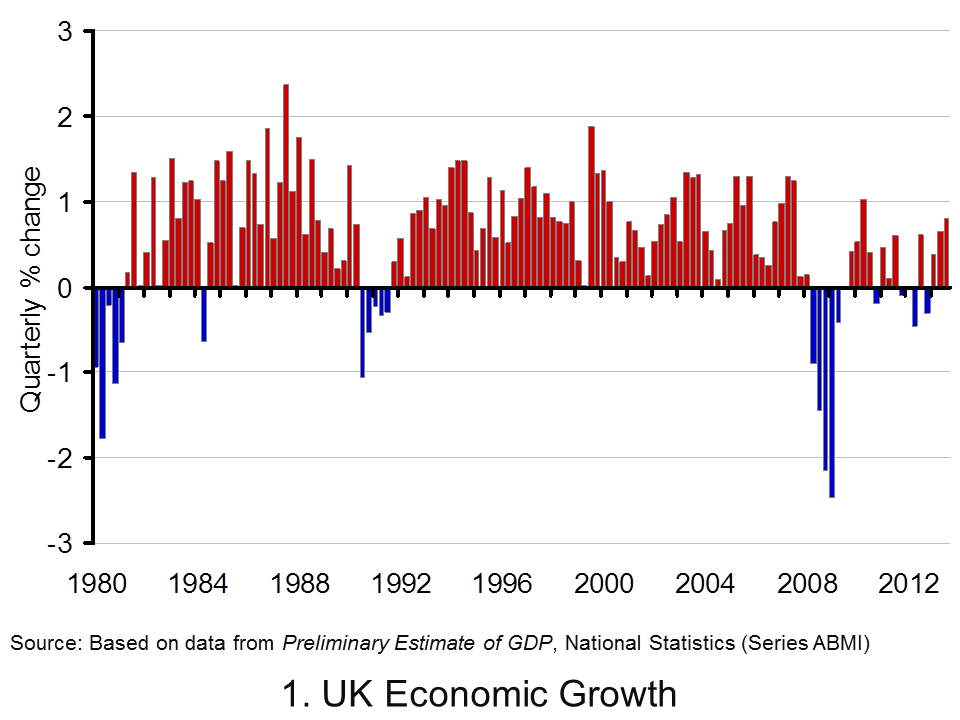 Chart 1 helps to put the recent growth numbers into an historical context. It shows the quarterly change in real GDP since the 1980s. From it, we can see the 5-quarter recession that commenced in 1980 Q1 when output shrunk by 4.6 per cent, the 5-quarter recession that commenced in 1990 Q3 when output shrank by 2.4 per cent and the 6-quarter recession that commenced in 2008 Q2 when output shrank by 7.2 per cent. (Click here to download a PowerPoint of the chart.)
Chart 1 helps to put the recent growth numbers into an historical context. It shows the quarterly change in real GDP since the 1980s. From it, we can see the 5-quarter recession that commenced in 1980 Q1 when output shrunk by 4.6 per cent, the 5-quarter recession that commenced in 1990 Q3 when output shrank by 2.4 per cent and the 6-quarter recession that commenced in 2008 Q2 when output shrank by 7.2 per cent. (Click here to download a PowerPoint of the chart.)
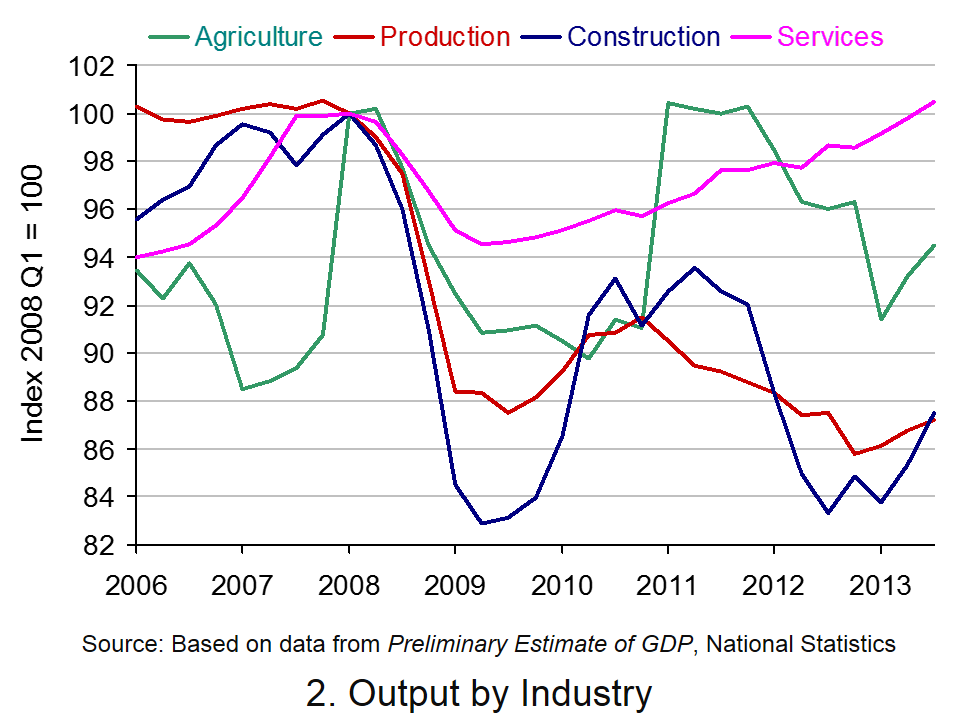 Chart 2 scratches a little below the surface by looking at output by the four principal industrial types. The interesting finding is that the output of the service sector has now risen above its 2008 Q1 peak. In 2013 Q3 output is 0.5 per cent larger. By contrast, the other three sectors remain smaller than in 2008 Q1. Agriculture, forestry and fisheries is 5.9 per cent smaller, construction 14.3 per cent smaller and production (including manufacturing) is 14.6 per cent smaller. (Click here to download a PowerPoint of the chart.)
Chart 2 scratches a little below the surface by looking at output by the four principal industrial types. The interesting finding is that the output of the service sector has now risen above its 2008 Q1 peak. In 2013 Q3 output is 0.5 per cent larger. By contrast, the other three sectors remain smaller than in 2008 Q1. Agriculture, forestry and fisheries is 5.9 per cent smaller, construction 14.3 per cent smaller and production (including manufacturing) is 14.6 per cent smaller. (Click here to download a PowerPoint of the chart.)
With today’s release, quarterly growth now averages –0.11 per cent since 2008 Q2. If we take the series back to the mid 1950s when it began, the average quarterly rate of growth is 0.64 per cent which is equivalent to an annual rate of increase of 2.57 per cent. While today’s news is encouraging it remains important to keep it in perspective and to ensure that growth is sustainable and built on firm foundations.
Data
Preliminary Estimate of GDP – Time Series Dataset Q3 2013 Office for National StatisticsGross Domestic Product Preliminary Estimate, Q3 2013 Office for National Statistics
New Articles
UK economy grows by 0.8% – the fastest pace in three years Guardian, Larry Elliott (25/10/13)
UK economy grew by 0.8% in third quarter Independent, Nick Renaud-Komiya (25/10/13)
UK GDP: fastest growth for three years BBC News (25/10/13)
UK economy grows by 0.8pc in third quarter Telegraph, Szu Ping Chu (25/10/13)
UK Economy: GDP Growth Accelerates To 0.8% Sky News (25/10/13)
Previous Articles
GDP grows 0.7% as UK economy shows steady recovery Guardian, Phillip Inman (26/9/13)
Hopes of economic recovery take double blow as GDP remains at 0.7% Independent, Russell Lynch (26/9/13)
UK economic growth confirmed at 0.7% BBC News (26/9/13)
IMF cuts global growth outlook but raises UK forecast BBC News (9/10/13)
Good news as IMF upgrades UK’s growth forecast Independent, Ben Chu (8/10/13)
Economy: IMF Makes UK Growth Forecast U-Turn Sky News (8/10/13)
Questions
- What is the difference between nominal and real GDP? Which of these helps to track changes in economic output?
- Looking at Chart 1 above, summarise the key patterns in real GDP since the 1980s.
- What is a recession? What is a double-dip recession?
- What are some of the problems with the traditional definition of a recession?
- Explain the arguments for and against the proposition that the UK has recently experienced a double-dip recession.
- Can a recession occur if nominal GDP is actually rising? Explain your answer.
- What factors might result in economic growth being so variable?
- What factors might explain the very different patterns seen since the late 2000s in the volume of output of the 4 main industrial sectors?
- Produce a short briefing paper exploring the prospects for economic growth in the UK over the next 12 to 18 months.
 The price of road fuel is falling. Petrol and diesel prices in the UK are now at their lowest level since February 2011. The average pump price for a litre of unleaded petrol has fallen to 130.44p in November – down nearly 8p per litre since September.
The price of road fuel is falling. Petrol and diesel prices in the UK are now at their lowest level since February 2011. The average pump price for a litre of unleaded petrol has fallen to 130.44p in November – down nearly 8p per litre since September. Good news for motorists as fuel prices fall in the East ITN (22/11/13)
Good news for motorists as fuel prices fall in the East ITN (22/11/13)








